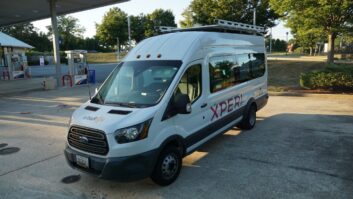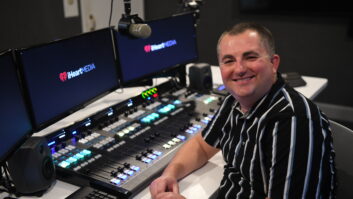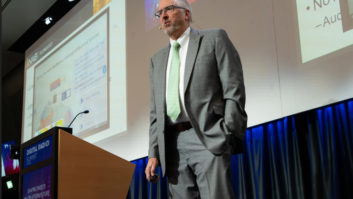Technical Implementation Seen as Closer to Success During Radio Show Sessions
Thanks to major innovations and technical refinements, attendees of technical certification sessions at this fall’s NAB Radio Show sensed HD Radio transmission moving to practical, cost-effective and successful realization. Every aspect of HD Radio technology has seen progress, from codecs to antennas. Those attending the sessions and studying the new introductions on the show floor could now say, “This is going to work.”
Beginning with the antenna:
Tom Silliman, president and CEO of ERI Inc., introduced what will be seen by many broadcasters as a stunning breakthrough, a dual — input side — mount FM antenna. Until now, the only type of antenna offering dual inputs was the master antenna panel array.
To utilize a single radiating element efficiently for both the HD and analog signals, dual inputs are required, one for each. Lacking dual inputs, high-level combining is necessary with its attendant efficiency compromise.
Having completed a full — scale working side — mount prototype of an omnidirectional, dual-feed, circularly polarized antenna, ERI states that “the design meets the current FCC requirement that all of the elements of an FM array be excited by both the digital and analog FM signals.”
The antenna is said to satisfy concerns in many areas raised when planning an FM HD Radio conversion. According to Bill Harland, product line manager of the Antenna Division of ERI, and Eric Wandel, director of product development, wind and weight loading will be comparable to an analog — only ERI antenna of the same gain and power — handling capability.
Thus there should be no tower load or leasing issues, excepting those of the small transmission line for the low-power digital signal. Gain in the vertical and horizontal planes will be identical for both signals, as will the inevitable distortions due to the mounting configuration, thus ensuring optimum digital integration. The antenna will be able to achieve VSWR of 1.05:1 for both analog and digital.
Another important technical specification is the requirement that the two signals be isolated in excess of -30 dB. The dual-input antenna achieves this eliminating any need for a circulator and its attendant cost and insertion loss.
ERI did not produce photographs or further technical details of the dual input antenna at the time of the introduction.
How it gets there
Understanding and predicting propagation of the RF signal is ever more important in the HD Radio environment.
Charles A. Cooper of duTriel, Lundin and Rackley Inc. discussed free-space propagation loss, terrain loss, plane earth path loss, knife edge diffraction loss and the Longley-Rice signal strength prediction algorithm as tools to ascertain probable signal quality.
He emphasized that Longley-Rice takes into account environment variables, while the FCC uses simple point-to-point predictions. Both are unreliable in complex RF environments such as urban canyons. Reportedly, HD Radio in practice is quite robust in such circumstances. HD Radio appears to thrive in multipath-ridden zones.
In the instance of a broadcaster with an existing Shively array, Bob Surette, director of RF Engineering for Shively Labs, discussing the interleaved antenna approach, gave assurance that it will be feasible to utilize new bays for the digital signal mounted between the present full — waved — spaced analog elements. The approximately 20-dB interbay coupling resulting from this method will require an isolator. He said that the presence of pattern modifying elements of a directional FM antenna will increase interbay isolation to a level of at least -27dB.
Scott Stull, director of broadcast business development for Ibiquity, introduced Jeff Detweiler, broadcast technology manager, who outlined and provided detailed information on the subject of the technical aspects of conversion to HD Radio.
Information similar to that presented at the spring NAB convention was given, with the important addition of the solution offered by the newly announced ERI dual — input side — mount antenna.
A major emphasis was placed on planning of the total air chain to minimize undesirable artifacting in the final encoding process. One problem discussed was the experience encountered by fans listening to a sports broadcast at the originating venue, frustrated by the “diversity delay” introduced by the HD Radio system. A solution is to broadcast a low-power, non-delayed analog signal within the confines of the venue. Jeff Detweiler stated that it was acceptable alternatively to eliminate the diversity delay during the period of the game by using the same technology as that of a profanity delay, but in reverse. There will remain an inherent latency, but the confusing 7+ second delay will be absent.
Mix engine
Ameliorating the increased complexity of the HD Radio transmission plant can be the simplicity of Ethernet interconnectivity.
“Broadcast facilities are still littered with the ghost of technology past,” said Steve Church of Telos Systems. Church and Michael Dosch, also of Telos, provided a workshop session titled “Ethernet for Studio Audio Systems.”
In his colorful fashion, Church observed that analog plus the plethora of digital formats such as AES3, MADI, S/PDIF and the many PC audio file types create a “Frankenstein’s monster of audio sources. We desperately need a standards-based approach to intelligently combining these disparate pieces.”
Telos’ Livewire technology is such a system; it has been reported here previously and was presented with a Radio World “Cool Concept” award at the NAB2003 Show. Church and Dosch emphasized the advantages of using an established, reliable and affordable technology such as Ethernet.
“Studio-grade reliability” can be realized, according to Church.
Building upon the cost-effective theme, a new concept was introduced as the core technology to be found in a new Livewire studio mix engine. Dosch and Church explained that a Pentium processor was a “pretty good DSP chip.” A motherboard with a Pentium III chip running Linux serves reliably as a cost-effective mix engine for each control surface. Connected to the system via an Ethernet port, the mix engine was described as flexible, efficient and affordable.
Maciej Szlapka, an engineer with Telos, demonstrated a software control window that simultaneously managed not only an audio router within the Livewire system but existing conventional routers as well. The Livewire system is in a live “radio broadcast test phase” in the United States and Europe.
It’s better
All considerations concerning HD Radio hinge upon not only acceptance by the listening audience, but an enthusiastic “Yes, this is better!” response.
Listening demonstrations were provided by Ibiquity of the new HDC codec. Stephen L. Wallace, broadcast marketing manager of Ibiquity, demonstrated to a Radio World writer the sound of live on-air Philadelphia AM and FM stations, exciter-driven simulated reception and a demonstration of the HDC codec in the 20 kHz “core” AM mode as well as the 36 kHz standard mode. The original reference audio also was available.
The new HDC codec performed competently in both AM and FM modes, and, to these ears, will no longer be an issue thwarting HD Radio acceptance. According to Detweiler, the HDC codec “survives very well” the inevitable transcoding to be encountered in the contemporary air chain. Listening to the on-air HD Radio AM signal and comparing it immediately to a conventional monaural AM signal did elicit in a “Yes, I like this!” reaction between this writer’s ears.
An important additional aspect of HD Radio is the wireless data that can be broadcast concurrently with the analog and digital audio. Program Associated Data (PAD) and Advanced Application Service (AAS) will not only provide such metadata as current program information but services as “on-demand personal radio,” premium navigational systems and real-time traffic updates, according to Detweiler. Joseph F. D’Angelo, director of wireless data for Ibiquity, directs those interested to www.ibiquity.com for white papers and further information.












